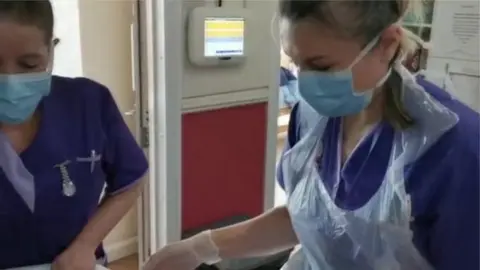Care homes: Questions and Answers
 BBC
BBCWho runs them?
Care Scotland, representing the sector, suggests that around 30% of care homes are small Scots-based companies, often with one or two homes. These are typically set up by health professionals, such as a nurse or doctor, who sees a market opportunity or a need in their local community.
Being small, they tend to lack the efficiency of larger chains in managing registration, complex regulation requirements, recruitment and staff training, buying equipment and food and raising capital.
A further 30% are run by mid-sized Scots-based chains of care homes. It is reckoned that fewer than 20% of care homes are owned through private finance.
It's claimed that share is falling, as Scotland is not seen as an attractive place to invest and make good returns. BUPA is down from 70 homes to only two. Four Seasons is down from 60 to 18.
HC1, which gained some notoriety over the Portree care home which saw a deadly outbreak of Covid-19, is the biggest private equity-owned operator in Scotland, with around 60 homes.
How profitable are they?
Property speculation can make them look profitable. But running the service does not look that way.
The CMA inquiry concluded UK care home profits are "positive, but not high". It said operators that cannot look to significant numbers of self-funded residents are financially vulnerable.
At present, with the health crisis, they are seeing insurance premiums sharply up, the cost of personal protective equipment has risen even faster, and staff shortages mean that many are only able to operate using overtime.
Scottish local authorities assume 4% profit when they calculate what they will pay for residential places. To cover other costs and increase profits, care homes have to rely more on self-funders, who pay significantly higher rates than councils.

Paying for care
The Scottish government funds personal care with £180 per month and nursing care with £81 monthly.
If you have savings and assets above £18,000, you have to pay towards the cost of care.
More than 70% of care home revenue comes from local councils.
5% of Scottish care home staff are from outside the UK, and higher in rural homes, where recruitment of EU nationals is important.

What about care at home?
Different funding and different operators, some are in-house council providers and many are from a patchwork of mainly small-scale private providers.
Low pay and poor working conditions are a feature of the sector, and it is often criticised for the short time that care workers are funded or scheduled to remain in people's homes, when they are often coping with complex needs.
Could there be a National Care Service, similar to the National Health Service?
If the intention is for the public sector to run a new NCS, government would have to buy out private owners, in a lot of expensive real estate, and then spend on upgrading property.
If care homes are run to the same specification or in the same way as local authorities, it is reckoned that costs per resident would rise by a third to a half. Much of that has to do with better employment conditions with councils.
There is public pressure to improve the lot of care workers. However that is achieved, it will require a big lift in funding.
Then there is demographic growth in the 'very old' age group, with the ageing of Baby Boomers and rising life expectancy. That will require more care provision, either at home or in residential homes.
One challenge for a National Care Service would be choice. The NHS runs efficiently because it rations access through queues. And you have to take the treatment and doctor you're offered.
Choosing a home for later life is usually seen as a more personal and long-term decision.
So yes, there could be a National Care Service. But we would probably have less choice, and we'd better be ready to pay a lot for it, through more tax or national insurance.
